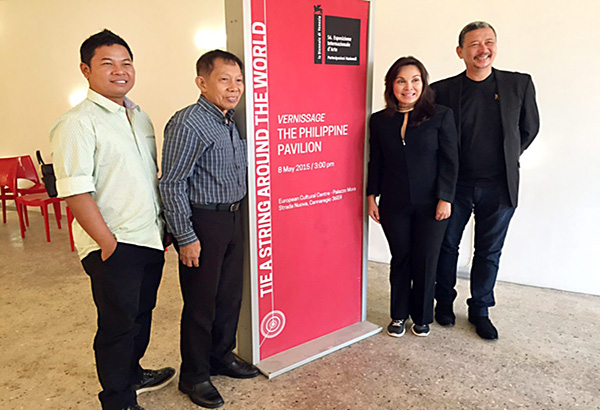Phl pavilion makes a splash at Biennale
May 8, 2015MANILA, Philippines – After a 51-year hiatus, the Philippines yesterday made a triumphant return to the world’s biggest and most prestigious art exhibition, the Venice Biennale.
Art News UK (a-n.co.uk) put the Philippine pavilion on its “10 Must-See National Pavilions” list, urging exhibition goers to see the “second official Philippine national participation… exploring the socioeconomic issues of sea nations, global politics and the volatility of borders through installation and film.”
Sen. Loren Legarda, main proponent behind the Philippine comeback, said, “I am thrilled that the Philippines is back in Venice after 51 years, the year that Okwui Enwezor is curating the central exhibition. Both the Biennale theme ‘All the World’s Futures’ and curator Patrick Flores’s ‘Tie a String Around the World’ are grounded in urgent geopolitical issues. Art is politics; art is global politics. This year’s Philippine pavilion shines a light on China’s hegemonic aggression and its incursions on Filipinos’ daily lives.”
Legarda said that Enwezor, the curator of the central exhibition in the Arsenale and Giardini in Venice, appreciated the Philippines’ being represented by UP art professor Flores, whom Enwezor knows and has worked with.
“Venice Biennale president Paolo Barratta is supportive of the Philippines’ return to Venice,” Legarda added. “We are even in the list of the 10 must-see national pavilions, based on a European press article!”
Curator Flores and artists Jose Tence Ruiz and Manny Montelibano made a strong statement in modest space: three rooms in Palazzo Mora to the west of the Biennale’s grand buildings and halls that have housed other countries for over a hundred years.
The first room shows Genghis Khan, the Manuel Conde film designed by Carlos “Botong” Francisco about the Mongolian conqueror who promised his ladylove that he would tie a string around the world and lay it at her feet.
Montelibano’s multi-channel video installation, A Dashed State, fills three walls of the second room. Filmed in the West Palawan sea, Montelibano says his 20-minute looped film is about “conquering nations and redefining boundaries. When Genghis Khan conquered almost all of Asia and parts of Europe, it was related to my dashed state about China.”
The third and final room is dominated by “Shoal,” Tence Ruiz’s massive red steel-and-velvet installation that looks like a bloody ghost ship, or “slum fortress,” in the artist’s own words, representing the BRP Sierra Madre run aground on Ayungin Shoal and used as a military outpost by the Philippine army as a deterrent against any Chinese incursions.
“I wanted it to be claustrophobic when you walked in, because the idea of power and identity is claustrophobic,” Tence Ruiz said of his work, which had to be shipped to Italy in 64 boxes containing hundreds of parts.
Both artists revealed they were given a budget of around P1 million each to fund their artworks for the Biennale.
National Commission for Culture and the Arts chairman Felipe de Leon Jr. said they were debating which symbol would best represent the Philippines: the rice terraces, coral reefs, the jeepney. “We decided that the best, most iconic symbol would be the balangay, or ship.”
Senator Legarda said her office, with a staff of three, helped her bring her dream of Philippine participation in the Biennale to fruition, from its conception in 2013 until the opening ceremonies, or Vernissage, on May 8.
“Our artists and curator made my vision and dream come true after they went through a rigorous screening process via the open call,” Legarda said. “It was not easy, so many bumps along the way. The very modest resources of government have brought us back to Venice for the upliftment of our gifted artists.”
The Philippines was in the biennale in 1964 when Jose Joya, who has since been declared national artist, was curator for an exhibit on new Philippine modernists.
Source: Philstar


